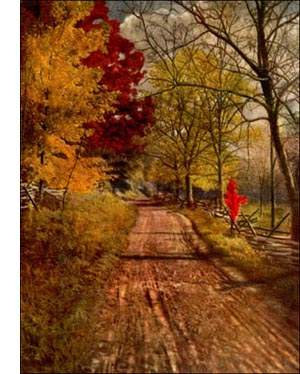Tamarack Larch Tree
 Tamarack (Larix Americana, Michx.)-A slender, pyramidal tree, 50 to 60 feet high, with feeble horizontal branches, becoming pendulous. Bark thin, broken into reddish scales. Wood heavy, hard, light brown, strong, coarse grained, resinous, durable in wet soil. Buds small, globular, red, shining. Leaves soft, deciduous, fascicled on side spurs, scattered on terminal shoots ; linear, triangular, 1/4 to 1 inch long ; autumn color, yellow. Flowers: monoecious, sessile, borne on short branchlets ; pistillate rosy, ovate, with conspicuous finger-like points on bracts ; staminate yellow, squat. Fruit small cones with concave, plain scales, bearing winged seeds ; annual. Preferred habitat, cold swamps and northern slopes of mountains. Distribution, Newfoundland and Hudson Bay west across the Rocky Mountains ; south into Minnesota, Illinois, Indiana and Pennsylvania. Uses: Posts, telegraph poles, railroad ties and ships' timbers.
Tamarack (Larix Americana, Michx.)-A slender, pyramidal tree, 50 to 60 feet high, with feeble horizontal branches, becoming pendulous. Bark thin, broken into reddish scales. Wood heavy, hard, light brown, strong, coarse grained, resinous, durable in wet soil. Buds small, globular, red, shining. Leaves soft, deciduous, fascicled on side spurs, scattered on terminal shoots ; linear, triangular, 1/4 to 1 inch long ; autumn color, yellow. Flowers: monoecious, sessile, borne on short branchlets ; pistillate rosy, ovate, with conspicuous finger-like points on bracts ; staminate yellow, squat. Fruit small cones with concave, plain scales, bearing winged seeds ; annual. Preferred habitat, cold swamps and northern slopes of mountains. Distribution, Newfoundland and Hudson Bay west across the Rocky Mountains ; south into Minnesota, Illinois, Indiana and Pennsylvania. Uses: Posts, telegraph poles, railroad ties and ships' timbers.The tamarack loves the Northern mountain slopes and the cold swamps of Labrador and Canada and our Northern States. It is the bravest of all the conifers, standing erect, a pitiful minia-ture of its true self, on the very edge of the Arctic tundras, a line that no tree dares overstep. Its companions, the black spruce, Balm of Gilead and an Arctic willow, are prostrate at its feet. In American lawns trees 6o feet high are often seen. But compared with the European tree this one is not a horticultural success. The mark of its life struggle with adversity is on the species. Even seedlings coddled in nursery rows have sparse crowns of unsymmetrical growth. In rich soil and among luxuriant oaks and pines and thick-leaved maples the tamarack looks ragged and forlorn. It is homesick for the cold, wet soil and the bleak wind and the valiant company of its kinsmen. It is an artistic and an ethical mistake to set one of these trees by itself. Plantations of it are justifiable.
Mountain bogs too deep to measure are covered with tamarack. The fibrous roots were the Indian's thread ; tough and fine as a shoemaker's "waxed end," it sewed the canoe of birch, making a seam that scarcely needed the wax of the balsam to make it water tight. Hiawatha sang :
"Give me of your roots, O Tamarack !
Of your fibrous roots, O Larch Tree !
My canoe to bind together
So to bind the ends together
That the water may not enter
That the water may not wet me."
The flowers of the tamarack are not conspicuous, but they repay the one who looks for them. The yellow staminate clusters, like little powdery knobs, soon fall, but the pistillate ones, conical, with green bracts alternating with rosy scales, are beautiful along the twig against the lettuce green of the opening foliage clusters. Erect and with scales spread, they catch the living pollen ; then close their scales and "hang their heads " throughout the summer. Under the rosy scales the seeds are growing. In autumn they wake up, turn themselves about (which seems quite unnecessary), and sitting quite erect on the twigs, part their brown scales, daring the wind to capture and carry off the winged seeds. There is plenty of time, for the ripe cones remain where they are until the second year.